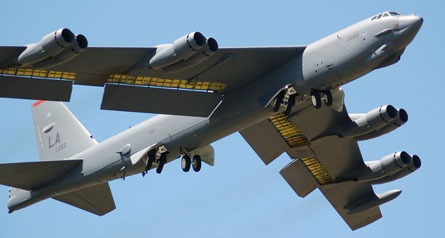The US military is poised to revive a once-aborted pillar of its airborne electronic attack strategy, prompting Boeing and Northrop Grumman to announce in advance a new partnership.
The US Air Force will seek preliminary approval on 30 October to launch an estimated $3.1 billion programme to develop an electronic attack role for its Boeing B-52 bomber fleet. Dubbed the Core Component Jammer (CCJ), the programme would revive an earlier concept to integrate long-range, phased-array jamming pods on the B-52's wing-tips.
 |
|---|
© Craig Hoyle/Flight International |
The previous attempt, known as the Standoff Jammer System (SOJS), was cancelled two years ago after estimated costs ballooned from $1 billion to $7 billion. The CCJ would be limited to early warning radar and communications in the lower frequencies of the spectrum, in hopes of avoiding the requirements creep that doomed the SOJS programme.
SOJS had attracted rival bids from Boeing and Northrop, but the new programme, if approved, would bring them together. The partnership displaces BAE Systems, which previously supplied the jammer technology for Boeing's team, and it is not yet clear whether BAE plans to also compete for the CCJ requirement.
The new partnership is modelled on identical co-operation on the US Navy's Boeing EA-18G Growler, in which Northrop supplies the jammer and receiver and Boeing integrates the system on the platform. "It became kind of a perfect fit," says Scot Oathout, a Boeing director of B-52 programmes.
Northrop plans to offer an all-new jammer that should be flightworthy within three years, and a receiver derived from the ALQ-218 installed on the EA-18G and the navy's Northrop EA-6B Prowler Improved Capability III aircraft.
However, Boeing and Northrop remain the two principal competitors for a potential stand-in jamming platform a requirement which remains dormant while the USAF considers whether to revive the competition between the Boeing X-45 and Northrop X-47 unmanned combat air vehicles.
Raytheon, meanwhile, is developing the Miniature Air-Launched Decoy-Jammer, which is scheduled to enter service after fiscal year 2009.
Source: Flight International
















